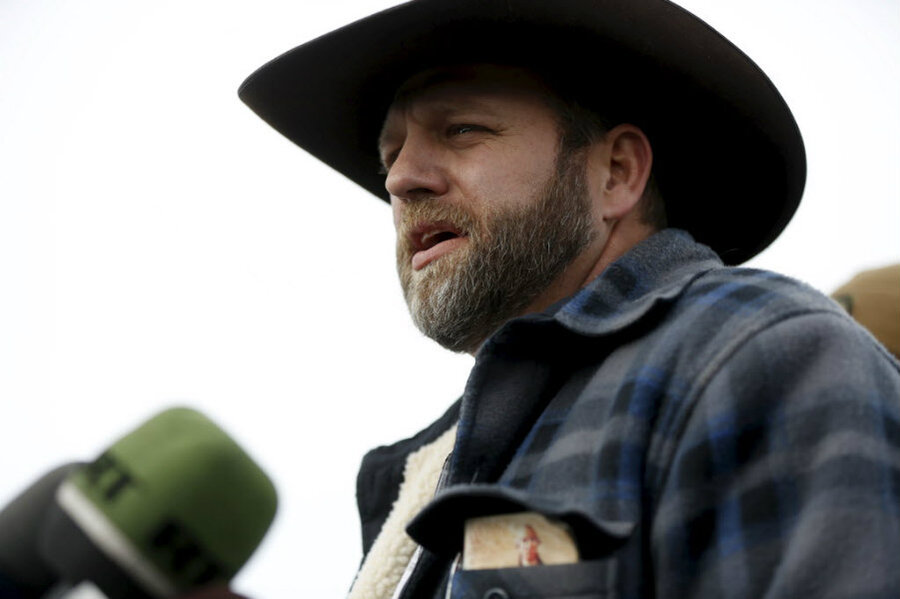Oregon militia standoff: What should the federal government do?
This weekend, armed antigovernment protesters took over a federal wildlife center in rural Oregon, saying they were willing to stay for years. The question is: What does the government do now?
The incident – the latest chapter in a longstanding conflict over federal land use in Western states that dates back to the Sagebrush Rebellion – points to an evolution in federal law enforcement's response after tragedies that resulted from similar standoffs in the 1990s, experts say. Since Waco and Ruby Ridge, law enforcement has learned to dial back its response, experts say. But, they note, Saturday’s takeover also suggests federal agencies have yet to find the “sweet spot” when it comes to dealing with armed protesters under siege.
“They clearly understand not to go in with guns ablaze,” says Richard White, a Stanford University professor of history who specializes in the American West. “I’m not sure what else they understand, though.”
In some ways, federal response to armed protests have shifted dramatically in the past two decades, experts say. In 1992, a confrontation between federal agents and Randy Weaver and his family at his home in northern Idaho ended in a shootout that resulted in the deaths of Mr. Weaver’s wife, Vicki, and 14-year-old son and Deputy US Marshal William Francis Degan.
A year later, federal and state law enforcement agents laid siege to and then raided a compound in Waco, Texas, that belonged to the Branch Davidians, a religious group suspected of weapons violations. Nearly 80 people died in the ensuing gun battle.
In both cases, “there was an unwillingness to understand who the people were inside the building and what their concerns were,” says Catherine McNicol Stock, a historian and director of the American Studies program at Connecticut College in New London, Conn. “The idea is, if [law enforcement agents] had approached [these groups] taking their religious beliefs seriously, they might have been able to do something that wouldn’t have been the tragedy that happened.”
By contrast, not a single shot was fired during the standoff in 2014 between the federal Bureau of Land Management (BLM) and Cliven Bundy, who had refused to pay $1 million in grazing fees or recognize the government’s authority over the land, Reuters reported at the time. Instead – citing public safety, the BLM suspended its siege of Mr. Bundy’s ranch in Bunkerville, about 80 miles north of Las Vegas, and returned some of the animals already seized.
“The heavy-handed kind of actions that were at Ruby Ridge and Waco back in the '90s, people digging in their heels – that’s what you want to try to defuse,” says David Schanzer, director of the Triangle Center on Terrorism and Homeland Security at Duke University in North Carolina. “Taking the low-key approach, preventing more people from joining this protest is the way to go.”
Yet while any response that avoids bloodshed is commendable – and many praised the BLM for its restraint during the Bundy incident – steps must also be taken to prevent such incidents from taking place again, Professor Schanzer and others say.
Heidi Beirich, head of the Intelligence Project at the nonprofit Southern Poverty Law Center in Montgomery, Ala., says the government’s failure to prosecute those involved in the Nevada incident in part led to Saturday night’s takeover of the Malheur National Wildlife Refuge, about 30 miles southeast of Burns, Ore.
“Nothing happened in the wake of [Nevada], and it emboldened them to take the steps they’re taking now,” Ms. Beirich says.
Indeed, Cliven Bundy’s son Ammon leads the group that now occupies the federal wildlife building: At the close of a rally Saturday for a pair of local ranchers convicted of setting fire to federal lands, the younger Bundy urged protesters to join him in taking a “hard stand,” The Washington Post reports. The group took over the wildlife refuge shortly after.
On Monday, the Federal Bureau of Investigation took the lead in responding to the Oregon standoff, saying it will coordinate with local and state officials to seek “a peaceful resolution to the situation,” according to the Post. That resolution, some say, should include holding those involved accountable.
“The law has to be enforced, whether that’s criminal law or civil penalties,” says Duke University’s Schanzer.
Beyond that, however, is a need for further engagement, he says. Law enforcement and minority communities are working to build trust in cities across the US. Those same community-building efforts should be extended to the extremes of white, rural America.
“Police forces should use these kinds of techniques – outreach and engagement, talking to people, getting to know them – as a kind of resistance against the popularity and growth of these kinds of movements,” Schanzer says.
“I think we’re always looking for the sweet spot between giving people the freedom to exercise their First Amendment right to protest and preventing people from lawbreaking and violence,” he continues. “I think that’s the principle that has to be applied equally here.”









